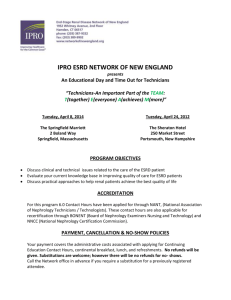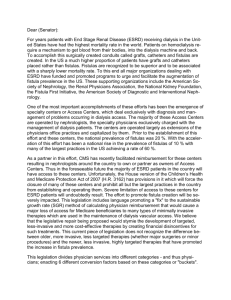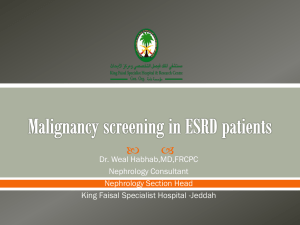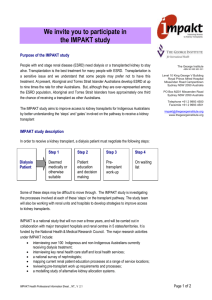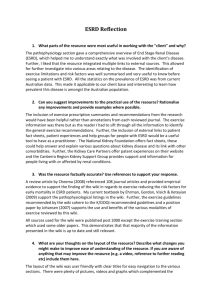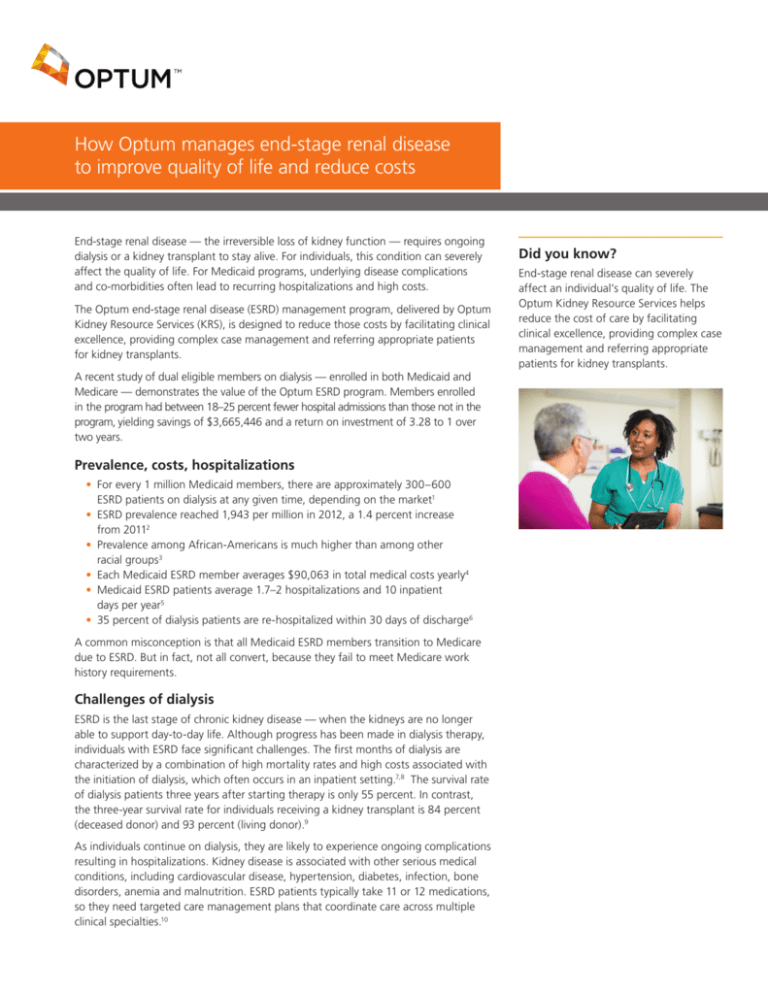
How Optum manages end-stage renal disease
to improve quality of life and reduce costs
End-stage renal disease — the irreversible loss of kidney function — requires ongoing
dialysis or a kidney transplant to stay alive. For individuals, this condition can severely
affect the quality of life. For Medicaid programs, underlying disease complications
and co-morbidities often lead to recurring hospitalizations and high costs.
The Optum end-stage renal disease (ESRD) management program, delivered by Optum
Kidney Resource Services (KRS), is designed to reduce those costs by facilitating clinical
excellence, providing complex case management and referring appropriate patients
for kidney transplants. A recent study of dual eligible members on dialysis — enrolled in both Medicaid and
Medicare — demonstrates the value of the Optum ESRD program. Members enrolled
in the program had between 18–25 percent fewer hospital admissions than those not in the
program, yielding savings of $3,665,446 and a return on investment of 3.28 to 1 over
two years.
Prevalence, costs, hospitalizations
• For every 1 million Medicaid members, there are approximately 300–600
ESRD patients on dialysis at any given time, depending on the market1
• ESRD prevalence reached 1,943 per million in 2012, a 1.4 percent increase
from 20112
• Prevalence among African-Americans is much higher than among other
racial groups3
• Each Medicaid ESRD member averages $90,063 in total medical costs yearly4
• Medicaid ESRD patients average 1.7–2 hospitalizations and 10 inpatient
days per year5
• 35 percent of dialysis patients are re-hospitalized within 30 days of discharge6
A common misconception is that all Medicaid ESRD members transition to Medicare
due to ESRD. But in fact, not all convert, because they fail to meet Medicare work
history requirements.
Challenges of dialysis
ESRD is the last stage of chronic kidney disease — when the kidneys are no longer
able to support day-to-day life. Although progress has been made in dialysis therapy,
individuals with ESRD face significant challenges. The first months of dialysis are
characterized by a combination of high mortality rates and high costs associated with
the initiation of dialysis, which often occurs in an inpatient setting.7,8 The survival rate
of dialysis patients three years after starting therapy is only 55 percent. In contrast,
the three-year survival rate for individuals receiving a kidney transplant is 84 percent
(deceased donor) and 93 percent (living donor).9
As individuals continue on dialysis, they are likely to experience ongoing complications
resulting in hospitalizations. Kidney disease is associated with other serious medical
conditions, including cardiovascular disease, hypertension, diabetes, infection, bone
disorders, anemia and malnutrition. ESRD patients typically take 11 or 12 medications,
so they need targeted care management plans that coordinate care across multiple
clinical specialties.10
Did you know?
End-stage renal disease can severely
affect an individual’s quality of life. The
Optum Kidney Resource Services helps
reduce the cost of care by facilitating
clinical excellence, providing complex case
management and referring appropriate
patients for kidney transplants.
How Optum manages end stage renal disease
to improve quality of life and reduce costs
The Optum ESRD program
Our ESRD program:
• Supports the provider-patient relationship and plan of care
• Applies evidence-based care standards and patient empowerment strategies to
reduce complications
• Evaluates clinical outcomes to improve overall health
Interventions focus on the specific issues facing ESRD patients and address the major
drivers of hospitalization and dialysis costs. Optum has developed more than 100
interventions using evidence-based guidelines from the National Kidney Foundation
Disease Outcomes Quality Initiative. KRS nurse advocates provide patient education,
dialysis monitoring and proactive management of co-morbidities related to renal
failure. This integrated approach to disease management is a critical factor in the
program’s effectiveness.
ESRD program interventions include:
1. Empowering patients
Dialysis patients must adhere to a complex regimen of diet and fluid restrictions,
medication, and dialysis therapy. KRS nurse advocates help patients make
appropriate choices and manage their condition, which has been shown to be
important in achieving positive health outcomes.11 KRS nurses also provide patients
and caregivers with educational tools and encourage the inclusion of valued peers
for additional support. In select markets, in addition to traditional telephonic case
management, Optum employs locally based nurse case managers who visit
patients at home, the dialysis center, doctor’s office or hospital.
2. Reducing complications
Cardiovascular disease is a leading cause of death in dialysis patients.12 KRS nurse
advocates apply evidence-based therapies including cardiovascular screening,
blood pressure control and medication management, and work with providers to
effectively reduce this risk.
Diabetes — one of the most common causes of ESRD — puts patients at heightened
risk for stroke, vision loss and other complications. Yet, only 30 percent of diabetic
ESRD patients receive comprehensive care including glycemic control monitoring,
lipid monitoring and eye exams.13 KRS nurses focus on improving diabetic care to
prevent complications.
3. Transplant education and referral
The kidney transplant waiting list continues to rise, reaching 81,981 candidates as
of year-end 2012.14 For dialysis patients 45–64 years old, only 19.1 percent in
2011 were either wait-listed for transplant or received a donor kidney within
one year of beginning therapy.15 Transplant education, early referral for
evaluation and assistance in maintaining transplant readiness are primary
objectives of the ESRD program.
4. Leveraging community resources
Connecting with community resources is an important KRS intervention. Nurse
advocates work closely with local dialysis centers, social workers, nutritionists and
agencies to coordinate transportation, meal delivery and home health services for
ESRD patients.
The Optum ESRD program interventions
are designed to:
• Empower patients
• Reduce complications
• Promote early referral for transplant
evaluation
• Leverage community resources
How Optum manages end stage renal disease
to improve quality of life and reduce costs
Targeting hospitalizations
ESRD patients typically undergo dialysis treatment for four hours, three times per
week. A common misconception among payers is that dialysis represents all, or nearly
all, of ESRD patients’ health care costs so, therefore, little can be done to impact
medical spend. In fact, 30–40 percent of the $90,000 annual spend on Medicaid ESRD
members is attributable to hospitalizations.16 Costs for admissions for Medicaid ESRD
patients are on average $15,000 per admit.17
Optum targets those costs by helping patients and providers minimize complications
stemming from ESRD, which often lead to emergency room visits and repeated
hospitalizations. For example, nurse advocates recommend that diabetic patients
monitor their feet and hands for circulation issues and wounds, since diabetics are
at increased risk of infection, which can lead to amputation if not resolved.
Saving $3,665,446
In 2012 and 2013, Optum analyzed ESRD program savings for dually eligible special
needs plan (D-SNP) members. These dual-eligible beneficiaries tend to be older and
carry a more advanced burden of co-morbidities.18 The study analyzed 757 members
on dialysis in 2012 and 847 in 2013. Enrollment in the ESRD program among these
members averaged 75 percent.
Optum compared inpatient admissions of DSNP members enrolled in the ESRD program
with those who were not enrolled:
• In 2012:
– For the first six months of dialysis, ESRD program enrollees had 25 percent fewer
inpatient admissions than non-enrollees
– Net program savings: $1,348,753
• In 2013:
– For the first six months of dialysis, program enrollees had 9 percent fewer
inpatient admissions than non-enrollees
– After the first six months of dialysis, enrollees had 18 percent fewer inpatient
admissions than non-enrollees
– Net program savings: $2,316,693
• Total savings: $3,665,446 over two years due to enrollees having fewer
hospital admissions
• Total ESRD program ROI: 3.28:1
Conclusion
Optum takes a proactive approach to managing ESRD, which is a complex, high-cost
condition. Our ESRD program provides evidence-based interventions, support for
providers’ individualized plans of care and clinical expertise through our team of
renal-trained nurse advocates. By identifying and resolving gaps in care, coordinating
treatment among multiple providers and reducing unnecessary hospitalizations,
the program reduces costs and improves health outcomes.
The numbers of patients with ESRD
are rising:
• ESRD has increased by 1.4 percent
since 20111
• 300–600 patients with ESRD for every
one million Medicaid members2
• Each Medicaid ESRD member
averages $90,063 in total medical
costs yearly4
How Optum manages end stage renal disease
to improve quality of life and reduce costs
Footnotes
1.Optum analysis of Medicaid managed care health plan data, average of 3 health plans with Medicaid membership of 125,000-325,000 lives. Review of kidney disease prevalence, inpatient admissions, length of stay and paid costs using 2010-2013 claims data, Sanders, 2/26/2014.
2. http://www.usrds.org/2014/view/v2_01.aspx.
3. http://www.usrds.org/2014/view/v2_01.aspx.
4. Optum analysis of Medicaid managed care health plan data, average of 3 health plans with Medicaid
membership of 125,000-325,000 lives. Review of kidney disease prevalence, inpatient admissions, length of
stay and paid costs using 2010-2013 claims data, Sanders, 2/26/2014.
5. Optum analysis of Medicaid managed care health plan data, average of 3 health plans with Medicaid
membership of 125,000-325,000 lives. Review of kidney disease prevalence, inpatient admissions, length of
stay and paid costs using 2010-2013 claims data, Sanders, 2/26/2014.
6. http://www.usrds.org/2014/view/v2_04.aspx.
7. http://www.usrds.org/2014/view/v2_05.aspx Figure5.3.
8. USRDS 2013 Annual Report. Volume 1, page 116-117.
9. http://www.usrds.org/2014/view/v2_05.aspx, Table 5.1.
10. http://www.ncbi.nlm.nih.gov/pmc/articles/PMC3817900/.
11. Schatell, Dori and Paula Stec Alt. How understanding motivation can improve dialysis practices. Nephrology
News & Issues, September 2008, pp. 32-36.
12. American Journal of Kidney Diseases, Vol 45, No 4, Suppl 3 (April), 2005: pp S8-S9.
13. http://www.usrds.org/2014/view/v2_03.aspx.
14. USRDS 2014 Annual Report. Volume 2, http://www.usrds.org/2014/view/v2_06.aspx.
15. http://www.usrds.org/2014/view/v2_02.aspx, Table 2.10.
16. Optum analysis of Medicaid managed care health plan data, average of 3 health plans with Medicaid
membership of 125,000-325,000 lives. Review of kidney disease prevalence, inpatient admissions, length
of stay and paid costs using 2010-2013 claims data, Sanders, 2/26/2014.
17. Optum analysis of Medicaid managed care health plan data, average of 3 health plans with Medicaid
membership of 125,000-325,000 lives. Review of kidney disease prevalence, inpatient admissions, length
of stay and paid costs using 2010-2013 claims data, Sanders, 2/26/2014.
18. Optum Dual-Eligible Special Needs Plan analysis, 2012-2013 claims data. Comparison of inpatient
admission rates for program-enrolled and non-program enrolled dialysis patients. Inverse propensity score
weighting adjusted for demographic and risk differences, costs based on allowed amounts, Haig, 8/11/2014.
1-866-427-6845 | optum.com
11000 Optum Circle, Eden Prairie, MN 55344
All Optum trademarks and logos are owned by Optum, Inc. All other brand or product names are
trademarks or registered marks of their respective owners. Because we are continuously improving
our products and services, Optum reserves the right to change specifications without prior notice.
Optum is an equal opportunity employer.
© 2015 Optum, Inc. All Rights Reserved. OPTCMC44749-012015


